As animal-aided therapy progresses in Malaysia, how man’s second best friend gives special needs kids renewed hope
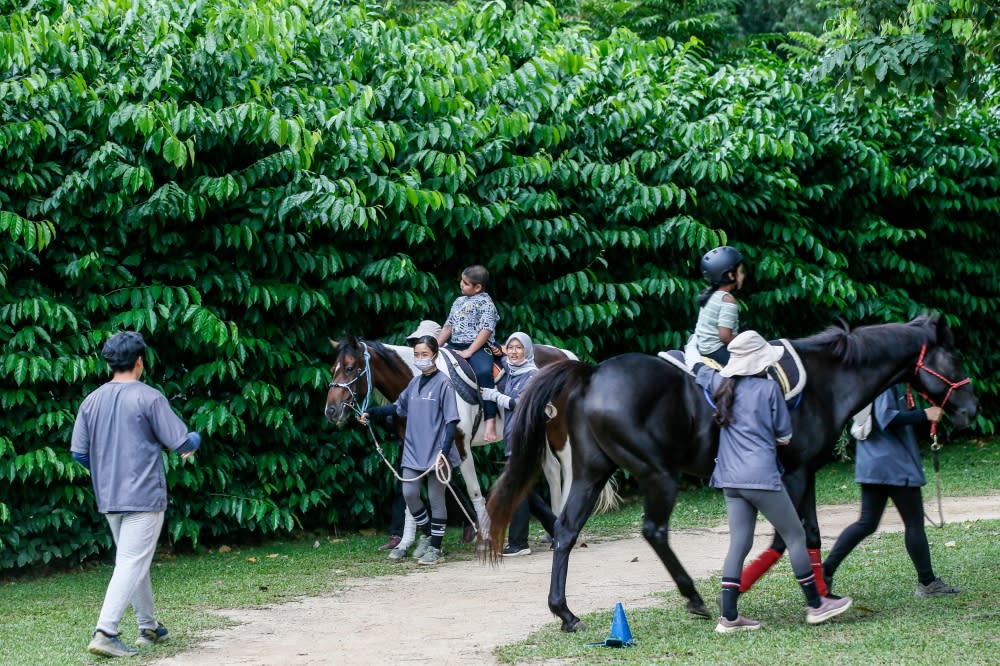
KUALA LUMPUR, Dec 18 — For centuries, human beings and horses have lived in coexistence for millennia, as both species would come to foster an unbreakable companionship bond that could only be rivaled by man’s best friend, the domestic dog.
Hunted as food by our ancestors, it was until centuries later around 3000 BC that mankind began domesticating wild horses for transportation, agricultural work, and warfare.
But it was not until the 1960s, where hippotherapy or equine-assisted treatment became a discipline with an established protocol and an adjunct to traditional physical therapy in mainland Europe.
By definition, hippotherapy is a medical treatment provided by a licensed occupational, physical or speech therapist through the use of a horse’s multidimensional movement to facilitate the achievement of therapeutic goals.
In Malaysia, hippotherapy was relatively unheard of up until the recent decade before being pioneered by paediatrician Dr Ali Azman Minhaj and his wife Iliza Ikhbal, whose co-founding of Green Apple Hippotherapy (GAH) at the Selangor Turf Club in 2014 is widely considered the country’s first.
“When you ask doctors, they don’t even know and assume we are talking about hippopotamus because the type of therapy was not even known then. It’s more of society’s ignorance,” Dr Ali Azman told Malay Mail in an interview at GAH recently.
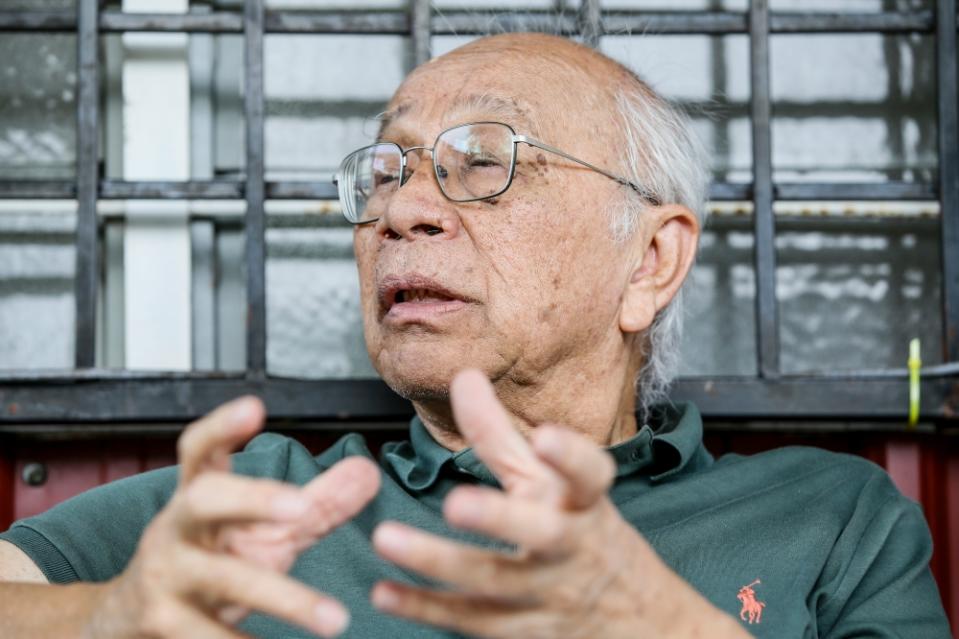
Co-founder of Green Apple Hippotherapy, Dr Ali Azman speaking to Malay Mail during an interview in his office at Selangor Turf Club in Serdang, December 10, 2023. — Picture by Hari Anggara
Dr Ali said GAH’s founding came about after his son, Mikhail, was diagnosed with autism spectrum disorder (ASD) at an early age when he began exhibiting typical autistic traits such as temper tantrums, hyperactivity, poor concentration and delayed speech.
“We initially started this among ourselves because our son, he is autistic. We went through various formal treatments and Iliza herself is an experienced horse rider.
“We later found that a lot of these special children undergoing hippotherapy recovered much faster and better, the improvement we see is so much more drastic, from then on we started researching to eventually bring this to Malaysia.”
So how does hippotherapy help special needs children like Mikhail and why horses?
“The movement of the horse is a very important feature. The way they walk or what we call gait is just like a human being when you put a human being side by side,” Dr Ali said of horses’ unique walking movement which cannot be replicated by other apparatus.
What this means is that the horses’ unique three-dimensional walk transfers variable, repetitive and rhythmic movement to the patient sitting atop which provides sensory input to the brain and nervous system, Dr Ali, who has almost four decades of paediatric experience, explained.
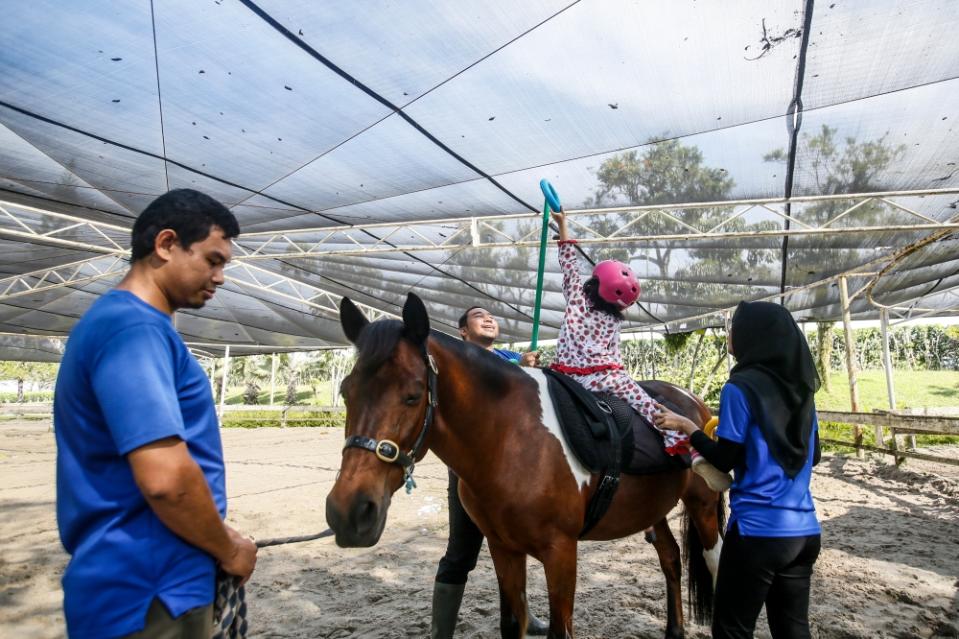
Special needs children attending hippotherapy sessions at Green Apple Hippotherapy at Selangor Turf Club in Serdang, December 10, 2023. — Picture by Hari Anggara
“The thing for autistic children is that their brain functions quite differently. With all these sensory stimuli coming in repeatedly by conducting hippotherapy outdoors, these children learn faster.
“Just like children, when you have a bumpy road difficult for cars to traverse, you repair it; but let’s say the road is too damaged to be even repaired, so you create a new road,” he said of neuroplasticity or the ability of neural networks in the brain to change through growth and reorganisation.
Dr Ali’s son, Faizal who is the GAH’s assistant manager, said their therapies incorporate games including roleplay to ensure a child’s participation to keep the children interested and improve their neural processing power.
“It’s all about stimuli to the brain, sensations of riding, hearing, smell, triggering our senses and this info tells the brain that this thing exists.
“When the children sit on the horses, they can feel the muscle movement (of the horse) themselves and every movement is subconsciously preventing them from falling, which means that the brain is working as it becomes stronger by developing new neurons to remember learned movement,” he said.
Several kilometres away at the administrative heart of Putrajaya, Happy Farms Hippotherapy (HFH) founder Nurdiyana Idros said special children as young as three years old could already participate in hippotherapy upon an assessment by a medical practitioner.
“Each minute astride a horse stimulates the child’s brain with up to 1,000 nerve impulses, so imagine how many impulses are stimulated in a 45 minute session ,” she told Malay Mail when met.
An occupational therapist by profession, Nurdiyana also started at GAH before she left and started her own centre with the motivation to see more people benefit from hippotherapy.
Like GAH, Nurdiyana too faced hurdles in correcting public and medical acceptance of hippotherapy.
“I have people telling me horses are expensive and why not use a water buffalo. I mean they have horns and are unwilling to listen to instructions!
“Some also think it’s dangerous and related to hippopotamus, so yes I had people making fun of it in the first few years like saying why are you running with horses when you can work in a hospital or a university,” she said.
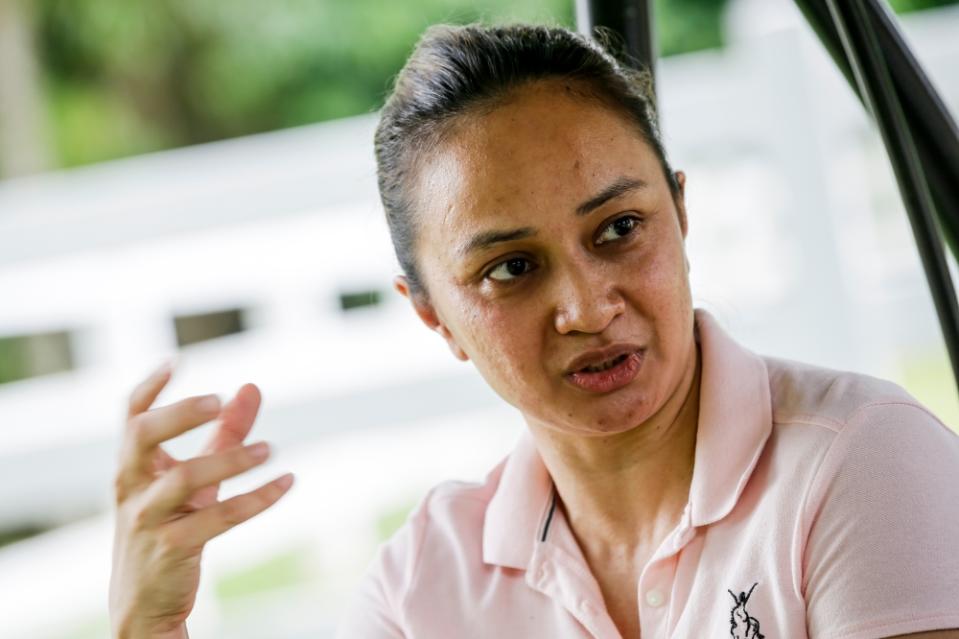
Co-founder of Happy Farms Hippotherapy, Nuridiyana Idros speaking to Malay Mail during an interview at Happy Farms Hippotherapy at the Horse Unit Complex in Putrajaya, December 10, 2023. — Picture by Hari Anggara
She also explained how the fundamentals of hippotherapy is based on the ‘Pyramid of Learning’, an illustration that depicts a general idea of children’s foundational skills and what other skills build upon those.
In the Pyramid of Learning, a child’s sensory system is identified in seven main senses, namely olfactory (smell), visual, auditory, gustatory (taste), tactile (touch), vestibular (balance) and proprioception (knowing where their bodies are in space).
This is followed by the next tier that depicts their sensory-motor development, then their perceptual motor development and finally their cognition intellect.
A child’s ability to plan their movements along with other sensory motor development characteristics, depend on the quality of their seven sensory systems; and their ability to attend formal learning and perform other cognitive intellect depended on their ability to adjust their posture and balance other perceptual motor development characteristics.
“So in hippotherapy, like it or not a child is required to sit upright and we do not use a saddle, its bareback so the connection between the horses’ movement and the children is very direct,” she said.
A brief history of hippotherapy
The word hippotherapy means ‘treatment with the help of a horse’, where the word hippos is derived from its ancient Greek’s origin meaning ‘horse’.
As early as the 5th century BC, Greek physician and philosopher Hippocrates - who is widely considered the father of medicine - wrote of the physical benefits of horseback riding in his book, Natural Exercise.
In his texts, Hippocrates wrote that “riding in clean air strengthens body muscles and keeps them in good form”.
However, it was not until centuries later during the 1952 Summer Olympics in Helsinki, Finland, that people began to notice the potential power of the horse-human connection.
This is after Lis Hartel, a Danish dressage rider, won an equestrian silver medal at the Games despite being partially paralysed from the knee down by polio she had contracted years prior.
Hartel’s experience was pivotal in revealing the potential healing power of the horse to the world at large and her pioneering works would eventually give new impetus for the development of modern day equine-assisted activities and therapies worldwide.
Debunking neigh-sayers
Contrary to general belief, therapy ponies used in hippotherapy have been carefully trained under supervision by licensed handlers and occupational therapists.
Geldings (male castrated horse) and mares are preferred as they tend to be well-behaved, easier to handle and gentler.
A normal therapy session consists of the horse, the patient, an occupational therapist, an assistant therapist (usually a physiotherapist) and a horse handler at all times.
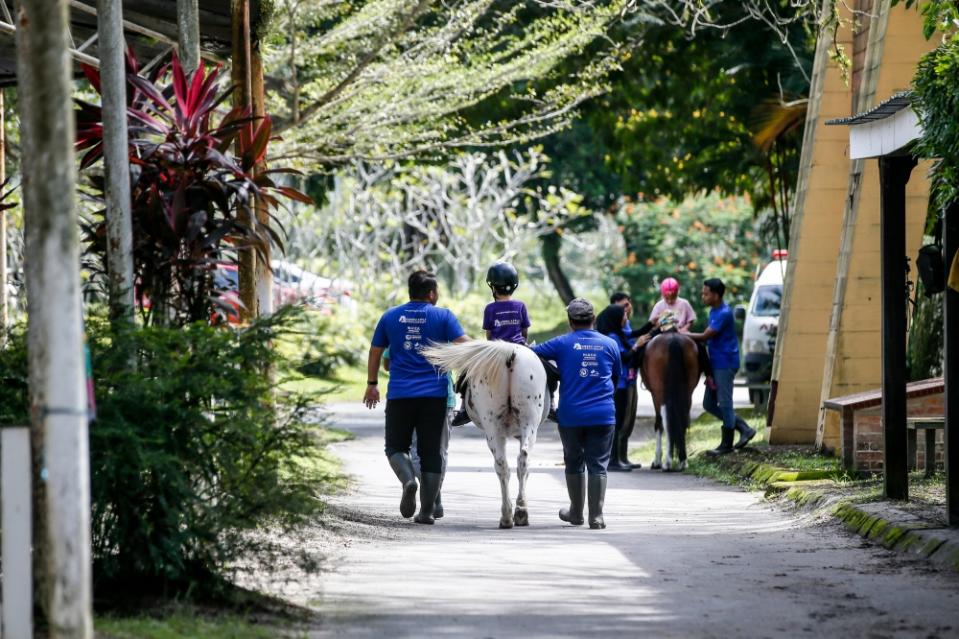
Special needs children attending hippotherapy sessions at Green Apple Hippotherapy at Selangor Turf Club in Serdang, December 10, 2023. — Picture by Hari Anggara
Therapists are also sent overseas to attend fundamental hippotherapy training in established hippotherapy centres in South Africa and Greece.
Patient assessment is also highly rigorous and each child undergoes a personalised therapy plan unique to their pre-existing condition that may take months or years.
Dr Ali said horses selected as treatment tools must have good temperament and calmness in nature, noting the creature’s innate ability to sense and respond to people’s emotion.
“Its size must be adequate enough to accommodate various children sizes, it does not matter what gender or breed they are but they must be trainable and not sensitive to any surprises,” he said of GAH’s resident ponies namely Tommy, Bambi and Rose.
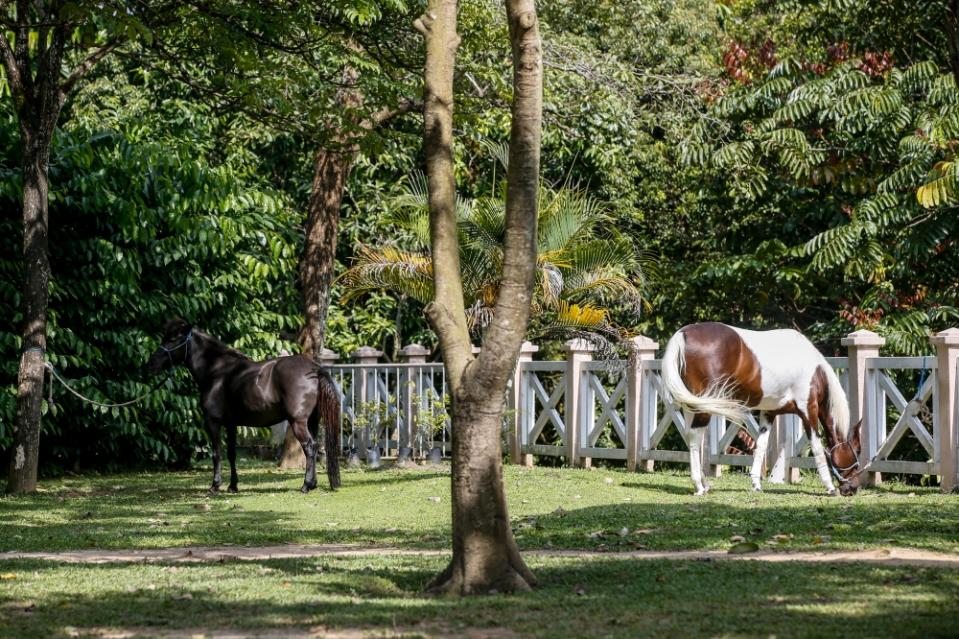
Horses being used for the hippotherapy sessions for special children are pictured at Happy Farms Hippotherapy at the Horse Unit Complex in Putrajaya, December 10, 2023. — Picture by Hari Anggara
Nuridiyana said it was more preferable to use local horses as compared to imported ones as the animals are accustomed to Malaysia’s climate.
“We trained all of our horses ourselves and our therapists are also horse riders themselves as they would know how to utilise the horse during treatment.
“Safety is number one in hippotherapy and since horses are fast in nature, we teach them to ‘slow down’ and listen to instructions,” she said of HFH’s resident ponies namely Didi, Dancer and Ney Ney.
She also said it was also important for horses to not have any downward bend in the back and have no racing history as they are easily spooked.
While hippotherapy generally benefits those suffering from ASD or cerebral palsy, the treatment has expanded to include those diagnosed with Down Syndrome, traumatic brain injury and even stroke.
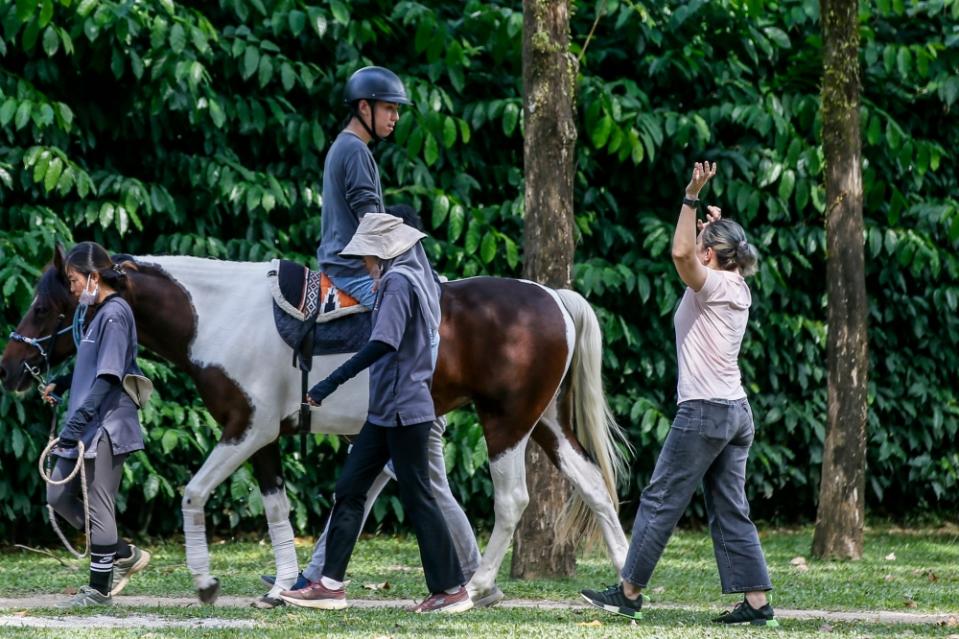
Nuridiyana Idros, co-founder of Happy Farms Hippotherapy (right) giving instructions on horse riding to Malay Mail reporter as part of the introduction to hippotherapy at Happy Farms Hippotherapy in Putrajaya, December 10, 2023. — Picture by Hari Anggara
Advocating safety and lifelong benefits
For Dr Ali and Nuridiyana, seeing the community, especially special needs children, benefit from hippotherapy is their lifelong goal amidst lingering public scepticism on animal-assisted therapy of those offered by unqualified service providers with no medical background.
“We do not aim to cure but we improve them to be more independent in their living skills because our parents won’t be around forever and they need to be independent, to have critical thinking as they assimilate into our community.
“I want parents to start sending their child for such therapy but look into their therapists’ background beforehand as some children are traumatised with horses because they went to the wrong place.
“I want all the special needs students to be no longer special, and they are normal, they can be inducted into normal society,” Nuridiyana said.
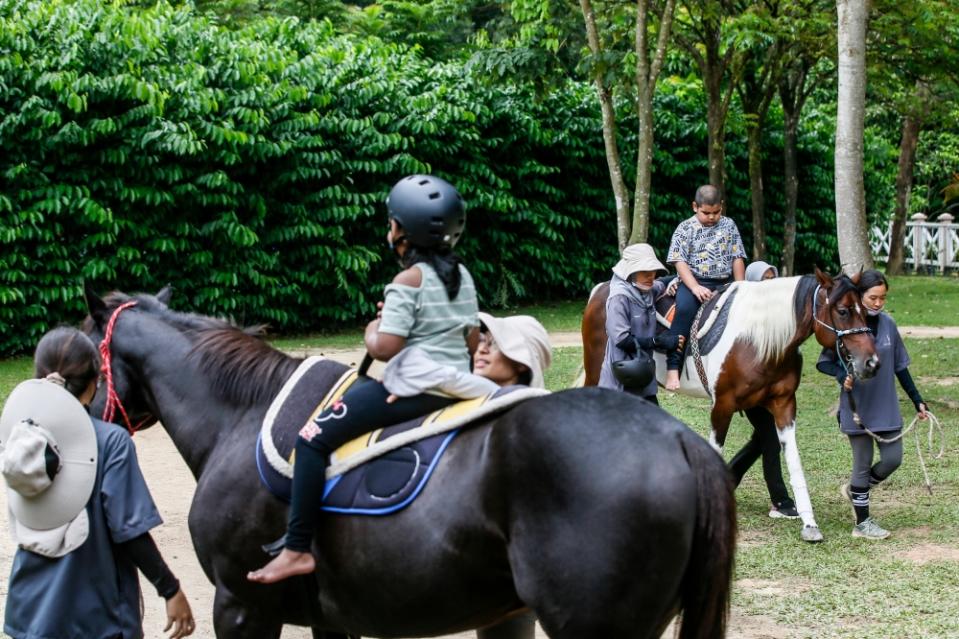
Special needs children attending hippotherapy sessions in the Horse Unit Complex at Happy Farms Hippotherapy in Putrajaya, December 10, 2023. — Picture by Hari Anggara
Dr Ali said nobody in the past thought of using horses for treatment, but thanks to decades of clinically proven research and literature, they are now being considered a crucial tool for assisted and therapeutic learning for special needs children.
“We are just at the tip of the iceberg. I am not not surprised that other people do not know since hippotherapy is an area that is something new.
“We are not here to advertise ourselves because we want things to be done properly, or else you will have people jumping in (the bandwagon) and creating havoc just because they see us producing good results,” he said.
As for Mikhail who is now a teenager, Dr Ali said he is now a changed person like his peers and has grown to love horseriding after undergoing hippotherapy throughout the years.
“He is now sitting for his International General Certificate of Secondary Education (IGCSE). He can socialise, able to discuss with people and able to study (normally),” he said proudly.
Tommy, Mikhail’s therapy horse, is still the same kind soul at heart; always giving his best to the special needs children he works with when the author met him.



